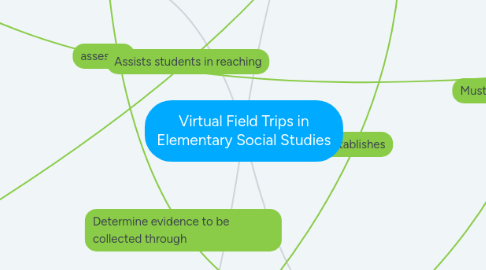
1. Learning Goals
1.1. Students will
1.1.1. Work Collaboratively
1.1.1.1. Participate in discussions based on observations
1.1.1.1.1. Evaluating historical questions or problems
1.1.1.2. Present research findings
1.1.1.2.1. created with
1.1.2. Conduct Research
1.1.2.1. Gather, analyze and Interpret data
1.1.2.2. Gain an understanding of historical events in context
1.1.2.2.1. by virtually
1.1.2.3. Explore role of historical agents
1.1.2.4. Construct a research document
1.1.3. Think Critically
1.1.3.1. Group inquiry before, after and during trip
1.1.3.1.1. through
2. Learning Activities
2.1. Involves
2.1.1. Creativity
2.1.1.1. Presentations
2.1.1.1.1. Created With:
2.1.1.2. Skits
2.1.1.2.1. Presented by:
2.1.1.3. Artwork
2.1.1.3.1. allows:
2.1.2. Exploration
2.1.2.1. using:
2.1.2.1.1. Fine motor skills
2.1.2.1.2. Physical materials
2.1.3. Collaboration
2.1.3.1. Discussions
2.2. Incorporates
2.2.1. Reading
2.2.2. Writing
2.2.3. Research
2.2.3.1. by:
2.2.3.1.1. Gathering Data
2.2.3.1.2. Exploring Themes
2.2.3.1.3. Analyzing Results
3. Learning Assessment
3.1. Based on:
3.1.1. Projects and/or Presentations
3.1.1.1. Measures:
3.1.1.1.1. Understanding, comprehension, analyzing, and synthesizing the materials being taught
3.1.1.2. Measured by:
3.1.1.2.1. Rubric
3.1.2. Interactive Peer and Teacher Discussions
3.1.2.1. Measures:
3.1.2.1.1. The ability to engage and learn with peers and teachers on understanding the material being taught
3.1.2.2. Measured by:
3.1.2.2.1. Rubric
3.1.3. Tests, Quizzes, Exit Tickets, and/or Checkpoints
3.1.3.1. Measures:
3.1.3.1.1. Comprehension of the material that was taught
3.1.3.2. Measured by:
3.1.3.2.1. Quizlet, Google Forms, paper pencil, etc.
4. Teacher Roles
4.1. is responsible for:
4.1.1. Providing constructive feedback
4.1.1.1. by:
4.1.1.1.1. answering questions
4.1.1.1.2. addressing misconceptions
4.1.1.1.3. evaluating progress formativly
4.1.2. Assessing learning
4.1.2.1. Grade assignment
4.1.2.2. Provide summative feedback
4.1.3. Facilitating learning
4.1.3.1. by:
4.1.3.1.1. Providing directions for learning activities
4.1.3.1.2. Asking questions to promote higher-order thinking
4.1.3.1.3. Providing technology support
4.1.3.1.4. Organizing additional activities
4.1.3.1.5. Interacting with students
